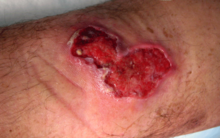Mycobacterium ulcerans
| Mycobacterium ulcerans | |
|---|---|
 |
|
| Scientific classification | |
| Kingdom: | Bacteria |
| Phylum: | Actinobacteria |
| Order: | Actinomycetales |
| Suborder: | Corynebacterineae |
| Family: | Mycobacteriaceae |
| Genus: | Mycobacterium |
| Species: | M. ulcerans |
| Binomial name | |
|
Mycobacterium ulcerans |
|
Mycobacterium ulcerans (M. ulcerans) is a slow-growing mycobacterium that classically infects the skin and subcutaneous tissues, giving rise to indolent nonulcerated (nodules, plaques) and ulcerated lesions. After tuberculosis and leprosy, Buruli ulcer is the third most common mycobacteriosis of humans. M. ulcerans grows optimally on routine mycobacteriologic media at 33 °C and elaborates a necrotizing immunosuppressive cytotoxin (mycolactone). The bacteria is considered microaerophilic. Large ulcers almost certainly caused by M. ulcerans were first observed by Cook in Uganda in 1897; however, the etiologic agent was not isolated and characterized until 1948 in Australia by MacCallum and associates.
Lesions of M. ulcerans disease have several synonyms (e.g. Bairnsdale or Searle's ulcer). The name Buruli is probably most appropriate for historic reasons, as it is a county of Uganda where important foci of the disease were studied.
The source(s) of M. ulcerans in nature is becoming clearer from epidemiologic data and from molecular biologic findings. Because all major endemic foci are in wetlands of tropical or subtropical countries, environmental factors must play an essential role in the survival of the etiologic agent. Koalas and possums are naturally infected animals in Australia. The disease is rarely transmitted from patient to patient. Trauma is probably the most frequent means by which M. ulcerans is introduced into the skin from surface contamination. Individuals of all ages are affected, but the highest frequencies of infection are in children under 15 years of age (Debacker et al. accepted for publication).
In many areas, M. ulcerans infection has only occurred after significant environmental disturbance. In the original paper describing the disease, published in 1948, the first patients presented in 1939 in the Bairnsdale District of Victoria, Australia. In December 1935, there had been terrible floods in the district, when all road and rail links had been cut and there had been considerable destruction of property. In Uganda, Barker examined cases of M. ulcerans infection (Buruli ulcer disease) occurring in the Busoga region on the east side of the Victoria Nile, north of Lake Victoria. Although cases were known in the other parts of the country, cases were unknown in the district before 1965. Barker postulated that the outbreak was related to the unprecedented flooding of the lakes of Uganda between 1962 and 1964 as a result of heavy rainfall.
...
Wikipedia
